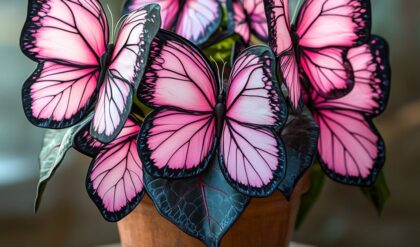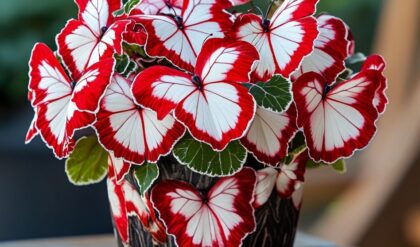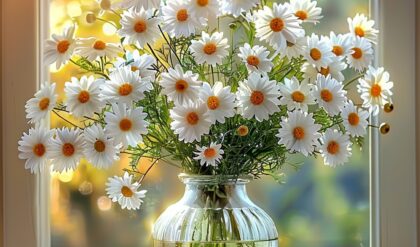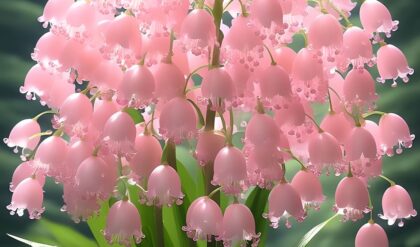
Black Bat Flower (Tacca chantrieri)
A mysterious plant with striking black bracts and whisker-like filaments, resembling eerie bat faces hanging in the jungle!
Light: Bright, indirect.
Water: Keep soil consistently moist, but not waterlogged.
Soil: Well-draining, rich in organic matter.
Temp: 70-80°F (21-27°C).
Humidity: High, 60-80%.
Fertilizer: Monthly, diluted balanced fertilizer during the growing season.
A truly unique and spooky addition to your plant collection!

In the realm of botanical wonders, few plants captivate the imagination quite like the Black Bat Flower (Tacca chantrieri). This enigmatic species, with its dark, dramatic blooms reminiscent of a bat in flight, stands as a testament to nature’s capacity for the extraordinary. Native to the tropical forests of Southeast Asia, the Black Bat Flower has long been shrouded in mystery, its unique appearance inspiring both awe and superstition. As we delve into the world of this remarkable plant, we’ll explore its fascinating characteristics, cultural significance, and the challenges it faces in an ever-changing world.
The Anatomy of Darkness: Understanding the Black Bat Flower
The Black Bat Flower is a marvel of natural design, its structure a complex interplay of form and function. Before we dissect its individual components, it’s important to understand that what we commonly refer to as the “flower” is actually an inflorescence – a cluster of flowers arranged on a stem. This intricate arrangement is what gives the Black Bat Flower its distinctive and haunting appearance.
The Wings of Night: Bracts and Their Function
At first glance, the most striking feature of the Black Bat Flower is undoubtedly its large, wing-like structures. These are not petals, as one might assume, but specialized leaves called bracts. Typically reaching up to 12 inches in length, these bracts are a deep, velvety purple-black, often described as having the texture of fine suede. Their dramatic coloration and size serve multiple purposes:

- Attraction: The dark, prominent bracts act as a beacon for pollinators, particularly in the low-light conditions of the forest understory where the plant typically grows.
- Protection: The bracts shield the actual flowers from physical damage and help regulate temperature and humidity around the delicate reproductive structures.
- Mimicry: Some researchers speculate that the bat-like appearance may serve as a form of protective mimicry, potentially deterring herbivores who might mistake the plant for a roosting bat.
The bracts’ texture is not just for show – the fine, velvety surface is believed to help in capturing and reflecting what little light is available in its shaded habitat, maximizing the plant’s ability to photosynthesize in low-light conditions.
The Heart of Darkness: True Flowers and Reproductive Structures
Nestled within the protective embrace of the bracts lie the true flowers of Tacca chantrieri. These small, inconspicuous blooms are arranged in clusters of 15-25 flowers, each no larger than a fingernail. Despite their size, these flowers are complex structures:

- Color: The flowers range from deep purple to nearly black, contributing to the plant’s overall gothic aesthetic.
- Structure: Each flower has six tepals (petal-like structures), six stamens, and an inferior ovary.
- Whiskers: Perhaps the most intriguing feature of the true flowers are the long, whisker-like filaments that extend from the flower cluster. These filaments, which can reach up to 28 inches in length, are believed to play a role in pollination, possibly by providing a “landing strip” for flying insects.
The reproductive process of the Black Bat Flower is still not fully understood. While self-pollination is possible, cross-pollination is believed to be the primary method, with small flies and gnats serving as the main pollinators.
Leaves and Stem: The Supporting Cast
While the inflorescence steals the show, the rest of the plant plays a crucial supporting role:
- Leaves: The Black Bat Flower produces large, elliptical leaves that can grow up to 2 feet in length. These leaves are a deep green color and have a glossy texture, helping to capture light in the plant’s shaded habitat.
- Stem: The plant’s stem is thick and fleshy, storing water and nutrients to help the plant survive periods of drought.
- Root System: Below ground, the Black Bat Flower develops a system of rhizomes – horizontal underground stems that can produce new shoots and roots. This allows the plant to spread and form colonies in favorable conditions.
The Fruit of Darkness: Seeds and Dispersal
After successful pollination, the Black Bat Flower produces round, fleshy fruits about 1-2 inches in diameter. These fruits are initially green, turning yellow or orange as they ripen. Inside, they contain numerous small seeds embedded in a sticky pulp.

The fruit’s appearance and structure suggest an adaptation for animal dispersal, likely by birds or small mammals attracted to the colorful, fleshy fruits. This method of seed dispersal helps the plant colonize new areas and maintain genetic diversity within populations.
Cultural Significance: The Black Bat Flower in Human Imagination
The Black Bat Flower’s unique appearance has captured human imagination for centuries, weaving its way into folklore, traditional medicine, and modern pop culture. Its dark beauty and mysterious nature have made it a symbol of the unknown, the supernatural, and the transformative power of nature.
Myths and Legends: The Black Bat Flower in Folklore
Across various cultures, the Black Bat Flower has inspired a rich tapestry of myths and legends. Its bat-like appearance and nocturnal associations have often linked it to the realm of the supernatural:
- Southeast Asian Folklore: In parts of Thailand and Malaysia, the Black Bat Flower is sometimes associated with spirits of the forest. Local legends speak of the plant as a manifestation of nature spirits, with some believing that picking the flower without proper respect could bring misfortune.
- Chinese Mythology: In certain Chinese traditions, the Black Bat Flower is seen as a symbol of longevity and transformation. Its ability to thrive in dark, challenging environments is viewed as a metaphor for resilience and adaptability.
- Western Gothic Traditions: Although not native to Europe or the Americas, the Black Bat Flower has been embraced by gothic subcultures as a symbol of darkness and mystery. Its incorporation into gothic gardens and artwork speaks to its powerful visual impact and otherworldly associations.
These diverse cultural interpretations highlight the plant’s ability to spark imagination and inspire reverence for the natural world’s more unusual creations.
Traditional Medicine: Healing Properties of the Black Bat Flower
Beyond its symbolic significance, the Black Bat Flower has a history of use in traditional medicine systems, particularly in its native Southeast Asia:

- Anti-inflammatory Properties: In traditional Vietnamese medicine, extracts from the plant’s rhizomes have been used to treat inflammation and swelling.
- Pain Relief: Some indigenous communities in Thailand have used preparations from the Black Bat Flower to alleviate various types of pain, including headaches and menstrual cramps.
- Digestive Aid: In parts of southern China, tea made from the plant’s leaves is believed to aid digestion and relieve stomach discomfort.
It’s important to note that while these traditional uses are intriguing, scientific research on the medicinal properties of Tacca chantrieri is limited. Any potential medical applications would require extensive study to verify efficacy and safety.
The Black Bat Flower in Modern Culture
In recent years, the Black Bat Flower has found a new audience, captivating plant enthusiasts, photographers, and artists around the world:
- Horticulture: Despite its challenging cultivation requirements, the Black Bat Flower has become a prized specimen for botanical gardens and adventurous home gardeners. Its dramatic appearance makes it a showstopping addition to tropical and gothic-themed gardens.
- Photography and Art: The plant’s unique structure and coloration have made it a favorite subject for nature photographers and botanical artists. Its otherworldly appearance lends itself well to surrealist and fantasy art styles.
- Fashion and Design: The Black Bat Flower’s distinctive silhouette has inspired designs in fashion, jewelry, and interior decor. Its gothic aesthetic aligns well with dark, romantic, and avant-garde styles.
- Conservation Symbol: As awareness of biodiversity loss grows, the Black Bat Flower has become a symbol of the need to protect rare and unusual plant species. Its striking appearance helps draw attention to the broader issues of habitat loss and the importance of plant conservation.
Cultivation Challenges: Growing the Black Bat Flower
Cultivating the Black Bat Flower is a endeavor that requires patience, dedication, and a deep understanding of the plant’s specific needs. Its reputation as a challenging species to grow has only added to its allure among plant enthusiasts and botanical gardens. Let’s explore the intricacies of Black Bat Flower cultivation and the obstacles that growers face.

Replicating the Rainforest: Creating the Ideal Environment
The first and perhaps most significant challenge in growing the Black Bat Flower is recreating its natural habitat. In the wild, Tacca chantrieri thrives in the understory of tropical rainforests, an environment characterized by:
- High Humidity: The Black Bat Flower requires consistent humidity levels of 60-80%. This can be challenging to maintain, especially in drier climates or indoor environments.
- Warm Temperatures: Ideal temperatures range from 68°F to 85°F (20°C to 29°C). The plant is sensitive to cold and can suffer damage at temperatures below 50°F (10°C).
- Dappled Sunlight: In its natural habitat, the Black Bat Flower receives filtered light through the forest canopy. Direct sunlight can scorch its leaves, while too little light can inhibit flowering.
Recreating these conditions often requires the use of humidifiers, temperature controls, and carefully managed lighting systems. For home growers, this often means dedicating a specific space, such as a greenhouse or terrarium, to create a microclimate suitable for the plant.
Soil and Nutrition: The Foundation of Health
The Black Bat Flower has specific soil requirements that can be challenging to meet:
- Well-draining Soil: The plant is susceptible to root rot, so a well-draining soil mix is crucial. A combination of peat moss, perlite, and orchid bark often works well.
- Slightly Acidic pH: The ideal soil pH for Black Bat Flowers ranges from 5.5 to 6.5. Maintaining this pH level requires regular monitoring and adjustment.
- Rich in Organic Matter: In its natural habitat, the plant grows in soil rich in decomposing plant material. Replicating this requires regular addition of organic compost or slow-release organic fertilizers.

Balancing these soil requirements while avoiding overwatering can be a delicate process, requiring careful observation and adjustment.
Watering Woes: Finding the Right Balance
Proper watering is perhaps the most critical and challenging aspect of Black Bat Flower care:
- Consistent Moisture: The plant requires consistently moist soil but is extremely sensitive to overwatering.
- Water Quality: Black Bat Flowers are sensitive to chemicals often found in tap water, such as chlorine and fluoride. Many growers use rainwater or distilled water to avoid these issues.
- Drainage: Ensuring proper drainage is crucial to prevent water from stagnating around the roots, which can quickly lead to root rot.
The challenge lies in maintaining high humidity and moist soil while avoiding the waterlogged conditions that can be fatal to the plant. This often requires a carefully planned watering schedule and close monitoring of soil moisture levels.
Propagation Predicaments: Expanding Your Collection
Propagating the Black Bat Flower presents its own set of challenges:
- Seed Propagation: Seeds can be difficult to obtain and have a low germination rate. They also require very specific conditions to sprout, including high humidity and consistent warm temperatures.
- Division: While division of mature plants is possible, it carries the risk of shock to both the parent plant and the divided sections. The process requires careful timing and execution.
- Slow Growth: Black Bat Flowers are slow-growing plants. It can take several years for a plant to reach maturity and produce its iconic flowers, testing the patience of even the most dedicated growers.
Pest and Disease Management: Vigilance is Key
While the Black Bat Flower is not particularly susceptible to pests, its high humidity requirements can create conditions favorable for certain problems:

- Fungal Issues: The humid environment can promote the growth of various fungi, including those that cause root rot. Proper air circulation and careful watering practices are essential to prevent these issues.
- Mealybugs and Scale Insects: These pests can occasionally infest Black Bat Flowers, particularly in greenhouse settings. Early detection and treatment are crucial to prevent widespread infestation.
- Nutrient Deficiencies: The plant’s specific nutritional needs can sometimes lead to deficiencies, manifesting as yellowing leaves or stunted growth. Regular, balanced fertilization is necessary to prevent these issues.
Conservation Efforts: Protecting a Natural Marvel
The Black Bat Flower, with its unique beauty and ecological significance, faces numerous threats in the wild. Conservation efforts are crucial to ensure the survival of this extraordinary species for future generations. Let’s explore the challenges facing the Black Bat Flower and the initiatives underway to protect it.
Threats to the Wild Population
Understanding the threats to the Black Bat Flower is the first step in developing effective conservation strategies:
- Habitat Loss: The primary threat to the Black Bat Flower is the rapid destruction of its natural habitat. Deforestation in Southeast Asia, driven by agriculture, logging, and urban expansion, has significantly reduced the plant’s native range.
- Climate Change: Alterations in temperature and rainfall patterns due to climate change pose a significant threat to the Black Bat Flower. These plants are adapted to specific environmental conditions, and even small changes can have profound effects on their ability to survive and reproduce.
- Over-collection: The plant’s popularity in horticulture has led to over-collection from wild populations. While cultivation has reduced pressure on wild specimens, illegal collection remains a concern in some areas.
- Limited Distribution: The Black Bat Flower’s naturally limited distribution makes it particularly vulnerable to local extinctions. A single event, such as a forest fire or disease outbreak, could potentially wipe out an entire population.
In-situ Conservation: Protecting Natural Habitats
Preserving the Black Bat Flower in its natural habitat is crucial for maintaining the species’ genetic diversity and ecological relationships:
- Protected Areas: Establishing and expanding protected areas in regions where the Black Bat Flower naturally occurs is a key strategy. This involves working with local governments and communities to designate national parks and nature reserves.
- Habitat Restoration: In areas where the Black Bat Flower’s habitat has been degraded, restoration efforts are underway. This includes replanting native species, controlling invasive plants, and recreating the forest understory conditions that the plant requires.
- Community Involvement: Engaging local communities in conservation efforts is crucial. This includes education programs about the importance of the Black Bat Flower and its habitat, as well as initiatives that provide sustainable livelihoods that don’t rely on forest destruction.
Ex-situ Conservation: Preserving Genetic Diversity
Complementing in-situ efforts, ex-situ conservation focuses on preserving the Black Bat Flower outside its natural habitat:
- Botanical Gardens: Many botanical gardens around the world maintain collections of Black Bat Flowers. These serve not only as living gene banks but also as centers for research and public education.
- Seed Banks: Storing seeds in specialized facilities helps preserve genetic diversity for future restoration efforts. However, the Black Bat Flower’s seeds are challenging to store long-term, requiring ongoing research into optimal preservation techniques.
- Tissue Culture: Advanced propagation techniques, such as tissue culture, allow for the reproduction of large numbers of genetically identical plants. This is particularly useful for preserving rare genetic variants of the Black Bat Flower.
Research Initiatives: Understanding for Better Protection
Ongoing research is crucial for developing effective conservation strategies:
- Genetic Studies: Research into the genetic diversity of wild Black Bat Flower populations helps identify unique variants that may be particularly important for conservation.
- Ecological Research: Understanding the plant’s role in its ecosystem, including its pollinators and symbiotic relationships with other organisms, is crucial for effective conservation planning.
- Climate Adaptation Studies: Research into how the Black Bat Flower might adapt to changing climate conditions can inform future conservation strategies, including potential assisted migration efforts.
International Cooperation: A Global Effort
Protecting the Black Bat Flower requires cooperation across borders:
- CITES Listing: The Convention on International Trade in Endangered Species of Wild Fauna and Flora (CITES) helps regulate international trade in threatened species. While the Black Bat Flower is not currently listed, there are ongoing discussions about its potential inclusion.
- Collaborative Research: International collaborations between botanists, ecologists, and conservation biologists facilitate the sharing of knowledge and resources crucial for protecting the species.
- Awareness Campaigns: Global awareness campaigns help raise the profile of the Black Bat Flower and other threatened plant species, encouraging public support for conservation efforts.
Sustainable Horticulture: Reducing Pressure on Wild Populations
Promoting sustainable cultivation practices can help reduce demand for wild-collected specimens:
- Nursery Propagation: Encouraging the development of nurseries specializing in ethically propagated Black Bat Flowers can help meet horticultural demand without impacting wild populations.
- Certification Programs: Developing certification programs for sustainably grown Black Bat Flowers could help consumers make informed choices and support conservation-friendly practices.
- Hobbyist Education: Educating plant enthusiasts about the importance of obtaining plants from reputable sources and the challenges of wild collection can help reduce demand for illegally collected specimens.
Conclusion: The Enduring Allure of the Black Bat Flower
The Black Bat Flower (Tacca chantrieri) stands as a testament to the incredible diversity and creativity of the natural world. Its striking appearance, challenging cultivation, and precarious status in



